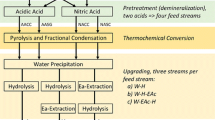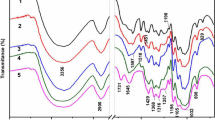Abstract
Common reed (Phragmites australis) is often recognized as a promising source of renewable energy. However, it is among the least characterized crops from the bioethanol perspective. Although one third of reed dry matter is cellulose, without pretreatment, it resists enzymatic hydrolysis like lignocelluloses usually do. In the present study, wet oxidation was investigated as the pretreatment method to enhance the enzymatic digestibility of reed cellulose to soluble sugars and thus improve the convertibility of reed to ethanol. The most effective treatment increased the digestibility of reed cellulose by cellulases more than three times compared to the untreated control. During this wet oxidation, 51.7% of the hemicellulose and 58.3% of the lignin were solubilized, whereas 87.1% of the cellulose remained in the solids. After enzymatic hydrolysis of pretreated fibers from the same treatment, the conversion of cellulose to glucose was 82.4%. Simultaneous saccharification and fermentation of pretreated solids resulted in a final ethanol concentration as high as 8.7 g/L, yielding 73% of the theoretical.




Similar content being viewed by others
Abbreviations
- DM:
-
dry matter
- ECC:
-
enzymatically converted cellulose
- FPU:
-
filter paper unit
- HPLC:
-
high performance liquid chromatography
- IU:
-
international unit
- SSF:
-
simultaneous saccharification and fermentation
- WO:
-
wet oxidation
References
den Hartog, C., Květ, J., & Sukopp, H. (1989). Aquatic botany, 35, 1–4. doi:10.1016/0304-3770(89)90062-4.
Ditlhogo, M. K. M., James, R., Laurence, B. R., & Sutherland, W. J. (1992). Journal of Applied Ecology, 29, 265–276. doi:10.2307/2404495.
Cowie, N., Sutherland, W. J., Ditlhogo, M. K. M., & James, R. (1992). Journal of Applied Ecology, 29, 277–284. doi:10.2307/2404496.
Ostendorp, W. (1989). Aquatic Botany, 35, 5–26. doi:10.1016/0304-3770(89)90063-6.
Tscharntke, T. (1992). Conservation Biology, 6, 530–536. doi:10.1046/j.1523-1739.1992.06040530.x.
Rolletschek, H. (1999). Limnologica, 29, 86–92. doi:10.1016/S0075-9511(99)80043-7.
Chambers, R. M., Meyerson, L. A., & Saltonstall, K. (1999). Aquatic Botany, 64, 261–273. doi:10.1016/S0304-3770(99)00055-8.
Marks, M., Lapin, B., & Randall, J. (1994). Natural Areas Journal, 14, 285–294.
Warren, R. S., Fell, P. E., Grimsby, J. L., Buck, E. L., Rilling, G. C., & Fertik, R. A. (2001). Estuaries, 24, 90–107. doi:10.2307/1352816.
Allirand, J. -M., & Gosse, G. (1995). Biomass and Bioenergy, 9, 441–448. doi:10.1016/0961-9534(95)00042-9.
Kauppi, P., Selkäinaho, J., & Puttonen, P. (1983). Annales Botanici Fennici, 20, 51–55.
Daniels, R. E. (1991). Aquatic Botany, 42, 41–48. doi:10.1016/0304-3770(91)90104-D.
Lissner, J., & Schierup, H. -H. (1997). Aquatic Botany, 55, 247–260. doi:10.1016/S0304-3770(96)01085-6.
Kühl, H., Koppitz, H., Rolletschek, H., & Kohl, J. G. (1999). Aquatic Botany, 64, 235–246. doi:10.1016/S0304-3770(99)00053-4.
Hansen, D. L., Lambertini, C., Jampeetong, A., & Brix, H. (2007). Aquatic Botany, 86, 269–279. doi:10.1016/j.aquabot.2006.11.005.
Granéli, W. (1989). Aquatic Botany, 35, 99–109. doi:10.1016/0304-3770(89)90070-3.
Weisner, S. E. B., & Granéli, W. (1989). Aquatic Botany, 35, 71–80. doi:10.1016/0304-3770(89)90068-5.
Lenssen, J. P. M., Menting, F. B. J., van der Putten, W. H., & Blom, C. W. P. M. (1999). Aquatic Botany, 64, 151–165. doi:10.1016/S0304-3770(99)00012-1.
Kresovich, S., Wagner, C. K., Scantland, D. A., Groet, S. S., & Lawhon, W. T.(1981). The utilization of emergent aquatic plants for biomass energy systems development. Report to Solar Energy Research Institute, Golden, Colorado Aquatic Species Program.
Kresovich, S., Wagner, C. K., Scantland, D. A., & Lawhon, W. T. (1981). Biomass, 1, 127–144. doi:10.1016/0144-4565(81)90021-4.
Duke, J. A. (1983). Handbook of Energy Crops: Phragmites australis (Cav.) Trin. ex Steud. Center for New Crops and Plants Products, Purdue University, West Lafayette, IN. Available from: http://www.hort.purdue.edu/newcrop/duke_energy. Accessed: May 15, 2008.
Fren, K. (1997). Plants for A Future: Edible and Useful Plants for A Healthier World. Hampshire: Permanent.
Hagelberg, E., & Lyytinen, S. (2007). in: Read Up on Reed (Ikonen, I., and Hagelberg, E., eds.), Southwest Finland Regional Environment Centre, Turku, Finland, pp. 94-101.
Börjesson, P. (1999). Biomass and Bioenergy, 16, 137–154. doi:10.1016/S0961-9534(98)00080-4.
Bridgeman, T. G., Jones, J. M., Shield, I., & Williams, P. T. (2008). Fuel, 87, 844–856. doi:10.1016/j.fuel.2007.05.041.
Jasinskas, A., Zaltauskas, A., & Kryzeviciene, A. (2008). Biomass and Bioenergy, 32, 981–987. doi:10.1016/j.biombioe.2008.01.025.
Pahkala, K., Aalto, M., Isolahti, M., Poikola, J., & Jauhiainen, L. (2008). Biomass and Bioenergy, 32, 1009–1015. doi:10.1016/j.biombioe.2008.02.004.
Landström, S., Lomakka, L., & Andersson, S. (1996). Biomass and Bioenergy, 11, 333–341. doi:10.1016/0961-9534(96)00041-4.
Hansson, P. A., & Fredriksson, H. (2004). Agriculture Ecosystems & Environment, 102, 365–375. doi:10.1016/j.agee.2003.08.005.
Granéli, W. (1984). Biomass, 4, 183–208. doi:10.1016/0144-4565(84)90056-8.
Burvall, J. (1996). Biomass and Bioenergy, 12, 149–154. doi:10.1016/S0961-9534(96)00064-5.
Hadders, G., & Olsson, R. (1996). Biomass and Bioenergy, 12, 171–175. doi:10.1016/S0961-9534(96)00047-5.
Björk, S., & Granéli, W. (1978). Ambio, 7, 150–156.
Monti, A., Di Virgilio, N., & Venturi, G. (2008). Biomass and Bioenergy, 32, 216–223. doi:10.1016/j.biombioe.2007.09.012.
Ahring, B. K., Jensen, K., Nielsen, P., Bjerre, A. B., & Schmidt, A. S. (1996). Bioresource Technology, 58, 107–113. doi:10.1016/S0960-8524(96)00090-9.
Bjerre, A. B., Olesen, A. B., Fernqvist, T., Ploger, A., & Schmidt, A. S. (1996). Biotechnology and Bioengineering, 49, 568–577. doi:10.1002/(SICI)1097-0290(19960305)49:5<568::AID-BIT10>3.0.CO;2-6.
Schmidt, A. S., & Thomsen, A. B. (1998). Bioresource Technology, 64, 139–151. doi:10.1016/S0960-8524(97)00164-8.
Klinke, H. B., Ahring, B. K., Schmidt, A. S., & Thomsen, A. B. (2002). Bioresource Technology, 82, 15–26. doi:10.1016/S0960-8524(01)00152-3.
Varga, E., Schmidt, A. S., Réczey, K., & Thomsen, A. B. (2003). Applied Biochemistry and Biotechnology, 104, 37–50. doi:10.1385/ABAB:104:1:37.
Hägglund, E. (1951). Chemistry of wood pp. 420–428. New York: Academic.
Kaar, W. E., Cool, L. G., Merriman, M. M., & Brink, D. L. (1991). Journal of Wood Chemistry and Technology, 11, 447–463. doi:10.1080/02773819108051086.
Boschker, H. T. S., & Cappenberg, T. E. (1998). FEMS Microbiology Ecology, 25, 79–86. doi:10.1111/j.1574-6941.1998.tb00461.x.
Szczodrak, J. (1988). Biotechnology and Bioengineering, 32, 771–776. doi:10.1002/bit.260320608.
Spindler, D. D., Wyman, C. E., Grohmann, K., & Mohagheghi, A. (1989). Applied Biochemistry and Biotechnology, 20/21, 529–540. doi:10.1007/BF02936507.
Ghose, T. K. (1987). Pure and Applied Chemistry, 59, 257–268. doi:10.1351/pac198759020257.
Berghem, L. E. R., & Pettersson, L. G. (1974). European Journal of Biochemistry, 46, 295–305. doi:10.1111/j.1432-1033.1974.tb03621.x.
Palmqvist, E., & Hahn-Hägerdal, B. (2000). Bioresource Technology, 74, 25–33. doi:10.1016/S0960-8524(99)00161-3.
Klinke, H. B., Olsson, L., Thomsen, A. B., & Ahring, B. K. (2003). Biotechnology and Bioengineering, 81, 738–747. doi:10.1002/bit.10523.
Klinke, H. B., Thomsen, A. B., & Ahring, B. K. (2004). Applied Microbiology and Biotechnology, 66, 10–26. doi:10.1007/s00253-004-1642-2.
Acknowledgement
This work was financially supported by the European Commission (ENK6-CT-2002-00604) and the National Research Fund of Hungary (OTKA-K72710). The Hungarian–Portuguese Intergovernmental S&T Cooperation Program (OMFB-00370/2007) is gratefully acknowledged for supporting the mobility of researchers (Costa-Ferreira, M., Kádár, Zs., and Szijártó, N.)
Author information
Authors and Affiliations
Corresponding author
Rights and permissions
About this article
Cite this article
Szijártó, N., Kádár, Z., Varga, E. et al. Pretreatment of Reed by Wet Oxidation and Subsequent Utilization of the Pretreated Fibers for Ethanol Production. Appl Biochem Biotechnol 155, 83–93 (2009). https://doi.org/10.1007/s12010-009-8549-4
Received:
Accepted:
Published:
Issue Date:
DOI: https://doi.org/10.1007/s12010-009-8549-4




